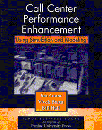Help
Desk & Support Center
Call Center
Management
Tech Support Resources
Project Management
Contact Center Technology
Online Support
Customer Satisfaction
Knock Your Socks Off
Service
Help Desk Institute
Telecom Books
Communication
Skills
Call Center Monitoring
Metrics & Benchmarking
CRM
Hiring, Training,
& Retention
Outbound Telebusiness
Novelties, Gifts, & Humor
Bargain Books (50% off)
Call
Center Courses
Telephony
Courses
ITIL
& Help Desk Courses
 |
Call Center Performance Enhancement: Using Simulation
and Modeling
by Jon Anton, Vivek Bapat, & Bill Hall, softcover, 134 pages, 1999, $53.95 |
You have some great ideas for how to increase the efficiency and quality of your call center. But before committing to some big investments, upper management wants to know which of your ideas and programs will have the greatest impact - in order. Will it be the new IVR technology? Offering customer support over the web? Providing additional training to CSR's? Combining multiple call centers? Outsourcing? Constructing more elaborate routing systems that route calls to specialists? Is there anyway to know?
Yes, there is. You can predict the impact of any of your intended performance improvements - or all of them - using simulation modeling techniques and tools.
If you have a complex call center, investing money in simulation tools, and investing your time in simulation modeling, can result in enormous performance and customer satisfaction gains for your company. This book discusses how and why you should consider making the move to this next level of call center management. Also provided is guidance on how to build a business case for acquiring simulation technology, how to select a simulation tool, and what factors to consider for your RFP.
Even if you are not ready for simulation modeling right now, read this book. You'll be glad you know where the industry is headed and what tools will be available when the size, complexity, and increased investment in your organization's call center demands increased performance from you as a manager.
Table of Contents
Chapter 1
An overview of the major changes taking place in today's call centers.
Chapter 2
The reader is introduced to simulation, with particular emphasis on "discrete
event" simulation. The chapter shows how discrete event simulation
has the ability to model the complexities of call center systems by including
the randomness and variability of call activity that occurs in the real world
Chapter 3
This chapter discusses the impact of technology on the call center and how
workforce management vendors are adding value to their products by including
simulation tools. Other analysis techniques are discussed and
differentiated (particularly Erlang), as well as why they don't measure up
to simulation and cannot meet the modeling needs of today's complex call
center.
Chapter 4
The reader is introduced to the types of call center applications where
simulation tools are most effective. Examples are given of tactical
and strategic uses and the steps to develop them, and the chapter concludes
with several examples of simulation modeling approaches.
Chapter 5
This chapter explains the trends in the industry and what drives them from
business and technological perspectives. Also discussed are some major
call center redesign options available today (e.g., centralization, outsourcing,
shared services, distributed environments, optimization, electronic access,
call routing, voice and processing integration) and how simulation can be
used to evaluate the effectiveness of these options.
Chapter 6
Learn how simulation can be used to determine whether the call center's current
level of service is generating the greatest return on investment.
Chapter 7
This chapter helps in the justification and selection of simulation tools
The book concludes with a series of call center simulation case studies described by the actual users of call center simulation tools from a variety of industries and environments.